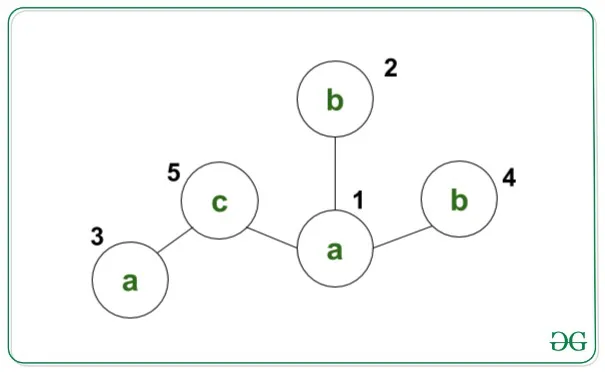Given an array arr[] consisting of N characters, the task is to generate a graph of N nodes and (N – 1) Edges such that each node i is associated with character arr[i] and no two adjacent nodes have the same value. If it is possible to make such a graph, then print “Possible” with the pairs of edges. Otherwise, print “Not Possible”.
Examples:
Input:_ N = 5, arr[] = {‘a’, ‘b’, ‘a’, ‘b’, ‘c’}_
Output:_ “Possible”_
1 – 2
1 – 4
1 – 5
5 – 3
Explanation:
One possible graph that can be constructed to satisfy the given conditions is as follows:
Input:_ N = 3, arr[] = {‘z’, ‘z’, ‘z’}_
Output:_ “Not Possible”_
Approach: To construct a graph such that no adjacent node has the same value, the idea is to check if atleast two unique values exists or not. If found to be true, such a graph can be constructed. Follow the steps below:
- Check for all the values present at each node and if all the node values are the same, it’s not possible to construct the graph.
- If any two values are different, there will always be a way to construct such a graph.
- Now, select any two unique values, connect the occurrence of all the other values to 1st unique value except the value itself.
- Store **indices **of occurrence of 1st unique value except for its first occurrence and connect all those indices to the second unique value.
- This way there will always be a way to construct such a graph with (N – 1) edges.
Below is the implementation of the above approach:
- C++
// C++ program for the above approach
#include <bits/stdc++.h>
**using** **namespace** std;
// Function that prints the edges of
// the generated graph
**void** printConnections(
vector<pair<``**int**``, **int**``> > store,
vector<``**int**``> ind, **int** ind1)
{
// First print connections
// stored in store[]
**for** (``**auto** pr : store) {
cout << pr.first << " "
<< pr.second << "\n"``;
}
// Check if there is more than one
// occurrence of 1st unique element
**if** (ind.size() != 0) {
// Print all other occurrence
// of 1st unique element with
// second unique element
**for** (``**auto** x : ind) {
cout << ind1 << " "
<< x + 1 << "\n"``;
}
}
}
// Function to construct the graph such
// that the every adjacent nodes have
// different value
**void** constructGraph(``**char** arr[], **int** N)
{
vector<``**int**``> ind;
// Stores pair of edges formed
vector<pair<``**int**``, **int**``> > store;
// Stores first unique occurrence
**char** x = arr[0];
**int** count = 0, ind1;
**for** (``**int** i = 1; i <= N - 1; ++i) {
// Check for the second
// unique occurrence
**if** (arr[i] != x) {
// Store indices of 2nd
// unique occurrence
ind1 = i + 1;
// To check if arr has only
// 1 unique element or not
count++;
// Store the connections of all
// unique elements with Node 1
store.push_back({ 1, i + 1 });
}
// If value at node (i + 1) is
// same as value at Node 1 then
// store its indices
**else** {
ind.push_back(i);
}
}
// If count is zero then it's not
// possible to construct the graph
**if** (count == 0) {
cout << "Not Possible"``;
}
// If more than 1 unique
// element is present
**else** {
cout << "Possible"
<< "\n"``;
// Print the edges
printConnections(store, ind, ind1);
}
}
// Driver Code
**int** main()
{
**int** N = 5;
// Given array having node values
**char** arr[] = { 'a'``, 'b'``, 'a'``, 'b'``, 'c' };
// Function Call
constructGraph(arr, N);
**return** 0;
}
Output:
Possible
1 2
1 4
1 5
5 3
Time Complexity:_ O(N)_
Auxiliary Space:_ O(N)_
Attention reader! Don’t stop learning now. Get hold of all the important DSA concepts with the DSA Self Paced Course at a student-friendly price and become industry ready.
#arrays #graph #greedy #searching #frequency-counting

